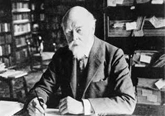
Isaac Newton, born in 1643, has been portrayed as living at a pivotal moment in history when the influence of magic and superstition was displaced by science. Because he lived at that moment, he reflected both of those influences: in his belief in alchemy on the one hand and his creation of physics as a discipline on the other.
Oliver Lodge, born two centuries later, represents a counter-example to this aspect of Newton’s historical uniqueness. Lodge illustrates that, well away from Newton’s time and within a single person, one can encompass the ability to make a major contribution to science and hold beliefs seemingly, today, inimical to a scientific outlook on life. In Lodge’s mind these characteristics were intimately related, and were publicly exposed in his reaction to his son Raymond’s death in World War One.
Lodge would not have been out of place as a physicist in the 21st (as against the 20th) century. He carried out distinguished work in both pure and applied physics, working on understanding electromagnetic waves and their use in telegraphy. He advocated the foundation of the National Physical Laboratory and he had a deep interest in public engagement with science. For example, within two weeks of Röntgen’s paper on the discovery of X-rays, Lodge had created an oversubscribed public exhibition of X-ray photographs, using money from an industrial benefactor: Hartley of jam renown.
However, there was another side to his interests, which was less appreciated by many of his colleagues: spiritualism. This, developing from an earlier interest in telepathy, captured his attention five years before he demonstrated the first transmission of signals by radio waves in 1894. Indeed he was led to believe the spirits inhabited the same substance, the aether, in which he thought the electromagnetic waves propagated.

These beliefs were expressed most publicly when his youngest son, Raymond, was killed in the First World War. Lodge was led (with the rest of his family) to believe they could communicate with Raymond via a medium. Their experiences were summarised in the very successful 1916 self-help book Raymond, written for other bereaved families.
From the vantage point of the 21st century this all appears to be very misguided. The Michelson-Morley experiment disproved the existence of the aether at the end of the 19th century, with Einstein’s explanation, via relativity, coming a few years later. This left Lodge stranded scientifically for the last 40 years of his life, as well as undermining the basis of his quasi-scientific view of spiritualism.
One might dismiss Lodge as an unfortunate example of a scientific dinosaur, garnished with a touch of the eccentric. However an examination of the list of the past presidents of the Society for Psychical Research reveals he was far from alone. Pillars of the scientific establishment such as the Lords Rayleigh are there, and at least one Nobel Laureate takes his place in the list, along with several eminent astronomers over the last century.
A final disquieting observation, from the perspective of our times, is that Lodge’s political views appear well ahead of his time. While he was Vice-Chancellor of the University of Birmingham he was a prominent supporter of the Suffragette Movement, and involved the undergraduates in running the University in an almost 1960s manner. This juxtaposition of views, (scientific or political) which we might regard separately as silly, or sensible, or admirably progressive, leads one to ask how the conventions, political or scientific, of current day scientists will be viewed in 100 years’ time.
Mike Gunn is Professor of Theoretical Physics at the University of Birmingham.